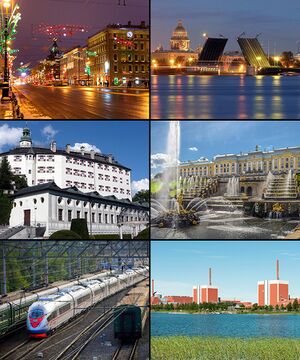Székesfehérvár
This article is incomplete because it is pending further input from participants, or it is a work-in-progress by one author. Please comment on this article's talk page to share your input, comments and questions. Note: To contribute to this article, you may need to seek help from the author(s) of this page. |
Székesfehérvár
Ruvelkan: Ůïűìḻûìüïṷṻíṷ | |
|---|---|
District Capital | |
 Clockwise from top: Ruvelya Avenue; Palace Bridge over the Kazanka River; Vilmos Palace; Székesfehérvár nuclear power plant; Villámlás high speed train; Szalai Historical Museum. | |
| Country | |
| District | Székesfehérvár District |
| Founded | 658 CE |
| Government | |
| • Body | Heves Council |
| • Governor | Krisztina Vilmos |
| Area | |
| • Total | 1,439.2 km2 (555.7 sq mi) |
| Elevation | 1,522 m (4,993 ft) |
| Highest elevation | 1,896 m (6,220 ft) |
| Population (2019) | |
| • Total | 6,844,620 |
Székesfehérvár (Ruvelkan Script: Ůïűìḻûìüïṷṻíṷ) is the second-largest city of Ruvelka with a population of 6,844,620 and is located on the banks of the Kazanka River at the northern confluence of the Kurilla and Matra mountain ranges. It is the capital of the Székesfehérvár District and a major cultural and industrial center of central Ruvelka. The high-speed rail line between Székesfehérvár and Debrecen is the most traveled rail route in Ruvelka and, as a result, the city is often considered Debrecen’s sister city.
Heves—the traditional region in which Székesfehérvár is located—was settled and developed by Ruvelkans in the 7th century while under the rule of the Makedonian Empire, eventually growing to become the seat of the Vilmos family and the capital of the Principality of Heves. Székesfehérvár’s influence continued to rapidly grow due to its location on a mountainous crossroads and access to plentiful resources; however, this brought the Principality of Heves into direct conflict with the Principality of Debrecen, resulting in an antagonistic relationship that would span several centuries. The Hevesian defeat during the Confederation Dispute in 1730 solidified Debrecen’s leadership and finalized the push for Ruvelkan unification.
Throughout the time period of the Ruvelkan Socialist Republic, Székesfehérvár was a major center of Imperialist sympathizers and was quick to support the Imperial Separatist cause during the Ruvelkan Civil War. It served as the effective base of operations for Paloma Keresztes’ Separatist Army Group South and was an important military and transportation hub.
Rich in Ruvelkan history, Székesfehérvár continues to be an important cultural and economic center in the modern Principality.